Having to pick from writing seasonal content and evergreen content is a major dilemma among us content writers. This article will show you the best solution to it!
You know content is king.
You also know content has great persuasive power.
You surely know if the content doesn’t provide value in the eyes of the customers or search engines, you are not doing the right thing.
But do you know the importance of constantly publishing new content to keep your website fresh and appearing on Google’s radar?
Now, a static website will languish, falling further and further down in search rankings. A site that regularly adds articles, infographics, videos, and other such content will be regularly re-indexed by Google.
Every successful online brand has learned the importance of creating user-focused content. In fact, content lies at the heart of SEO and content marketing. Without content, there is no such thing as SEO or marketing. Search engines, like Google, relies vehemently on content and links in order to function or adequately serve their users with what they are looking for.
It can be hard to choose the type of content that works best. Some brands (depending on the niche) may find that long-form of content works better in their industry, some preferred infographics while others choose the path of certain topics like tutorials and how-to articles.
Nonetheless, there are so many dimensions of written content and the variables are overwhelming. Broadly speaking, you have two choices. Seasonal content reflects what’s happening at the moment. Evergreen content, in contrast, is always relevant. Most of us will reach a point of a dilemma on which should be the way to go.
A visitor may be looking for seasonal content while another searcher could be looking for the general evergreen content. As a business looking to market your products or services, which content strategy should you choose?
Let’s find out.
What is Evergreen Content?

As its name implies, evergreen content covers constant, unchanging topics. It’s timeless and is intended to last forever regardless of specific events or seasonal changes. Keywords for evergreen content are searched over and over all year round and remain relevant at all periods.
| My Pick on SEO Tool: Because keywords act as a foundation for any quality SEO strategy, BiQ’s Keyword Intelligence can help you in your keyword research efforts. With the tool, you are able to find related keywords so you aren’t repeating the same keywords throughout your content. |
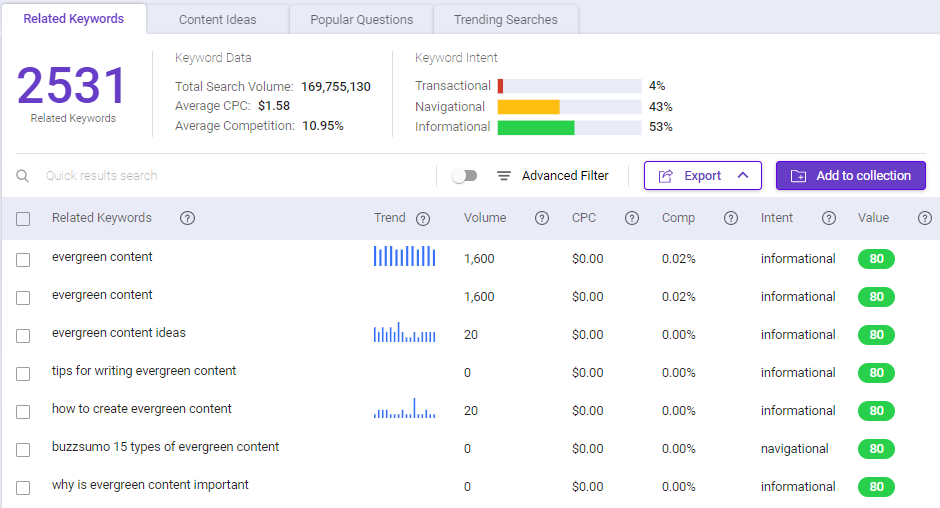
Here’s another top pick if you’re interested to focus your search on search volume, CPC, and competition presented in the fastest way possible, then take a look at LiveKeyword. This tool lets you check related keywords and important metrics right from your browser!
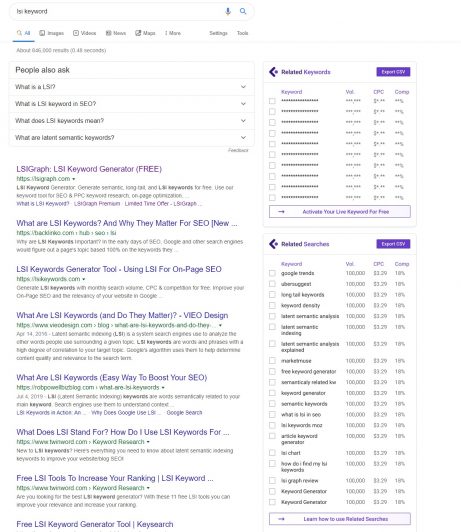
Evergreen articles are not:
- Latest trending ideas of clothing and fashion
- Content about specific holiday or season
- News articles
- Latest numerical statistics or reports that will go out of time
For example, if you run an e-commerce store selling fishing gear, an evergreen article might be “Fly fishing casting for beginners.” This is a subject that hasn’t changed since about 1910. It will never go out of style. There will be aspiring fishermen searching for this for all eternity.
Some nice articles that rarely get old are parenting, pet care, weight loss, finance, money-saving tactics, and careers among several others. If you think of it, evergreen content is essentially made to educate audiences. Most of them are in the form of case studies, statistics, how-to guides, lists, tips are some instances of evergreen content.
What is Seasonal Content?

Seasonal content, which might also be thought of as topical content, describes subjects that are relevant at a particular time. Basically, those content are newsworthy, often indicated as #breaking on Twitter. These stories cannot be prepared in advance and require responses as they occur.
For instance, a fishing store site might publish a seasonal piece called “How to catch a bass in Wyoming in July.” as this is much more specific and time-limited. Some other contents that would fall under seasonal content include:
- How to decorate your house for Christmas
- 5 special gifts to get your Valentines date
- How to keep warm during winter
- Budget-friendly ideas for a Halloween party
My Pick on SEO Tool: Google Trend is pretty handy in letting you know the seasonal trends of certain products – or your niche. It shows the popularity of a search term in Google. You may also find other details such as demographic insights, related topics, and related queries to help you understand trends better. 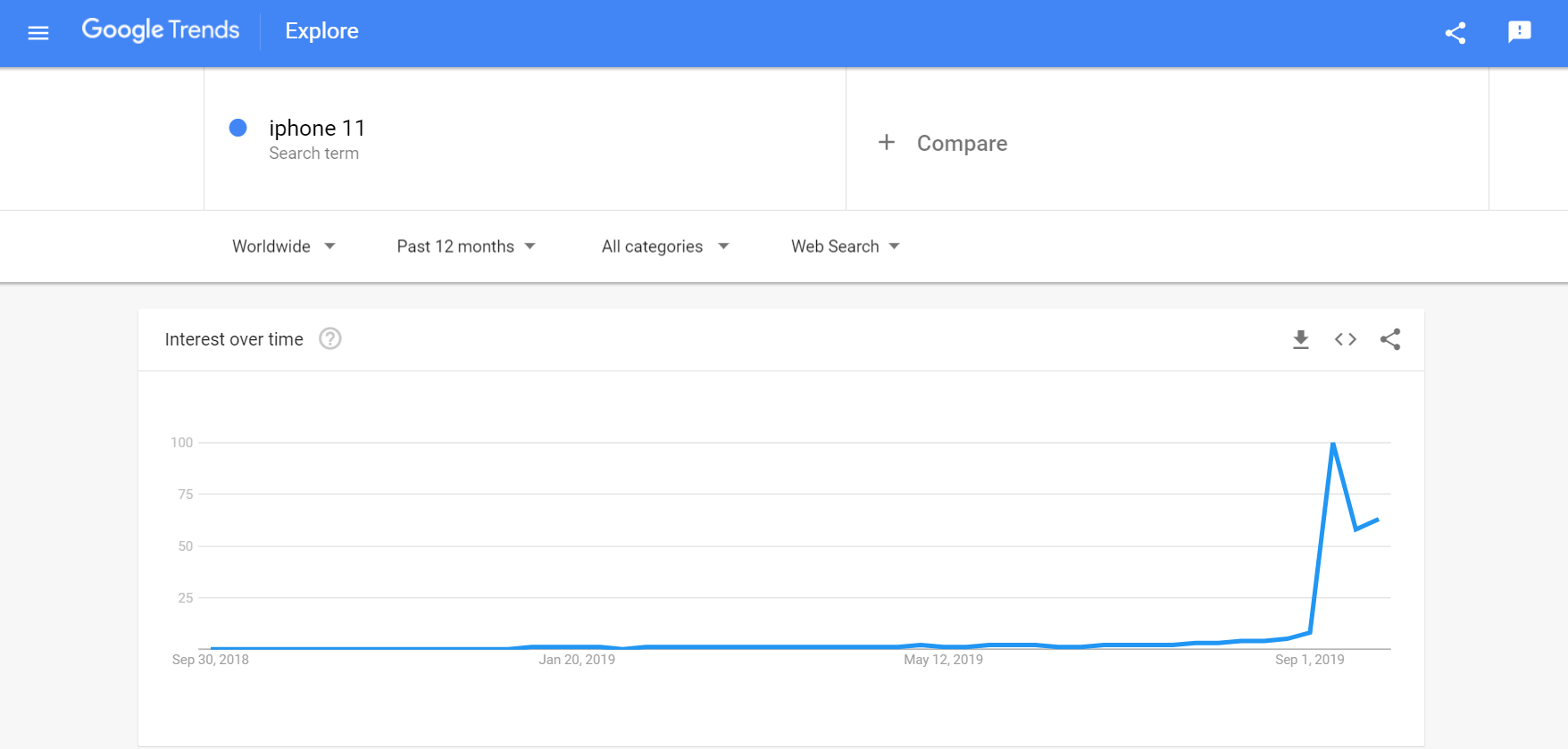 |
Anyhow, when it comes to seasonal content, timing is everything. Publish an article too early and you might not catch the attention of your core readership. Market it too late and you risk being lost in the masses.
High-Level Pros and Cons of Each Approach
Here is the point;
A website visitor may be looking for seasonal content while another searcher is looking for general evergreen content. As a business looking to market your products or services, you must have wondered which content strategy should you choose?
Now that you’ve understood the differences between seasonal and evergreen content, let’s look at the benefits and drawbacks of evergreen content vs seasonal content on a deeper scale to help you in your decision-making.
Evergreen Content Pros
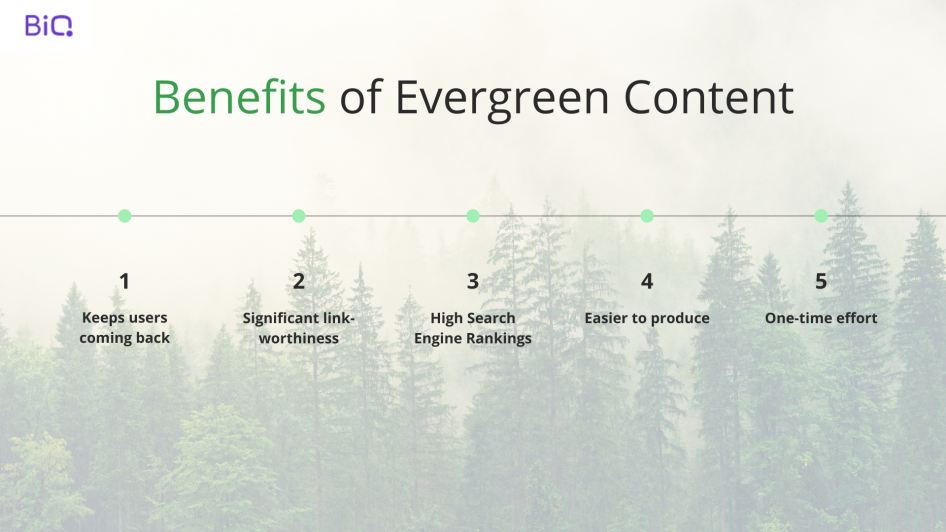
1. Keeps users coming back
If evergreen content lives on your website, it increases the chances that users will go back to your site to reference it, indirectly helping you to increase traffic and overall authority. This also bolsters your lead generation efforts when done right.
2. Significant link-worthiness
When you want to promote your own evergreen content, try creating ideas for new blog posts that will naturally link back to your evergreen posts. Pick a piece to promote, and ideate around it.
3. High Search Engine Rankings
Because of the quality and timeliness of evergreen content, it usually ranks very well on search engines over time. Better results can be seen when paired with well-optimized keywords.
4. Easier to produce
This is because it is based on general knowledge and commonly understood concepts that your users might have already been exposed to. There’s also no rush to produce it on any particular deadline, fearing the failure to on the current stage.
5. One-time effort
The clear benefit of evergreen content is that you only need to create it once – meaning there is usually one big burst of effort. Despite that, the rewards can still be seen rolling in even years later.
Evergreen Content Cons:
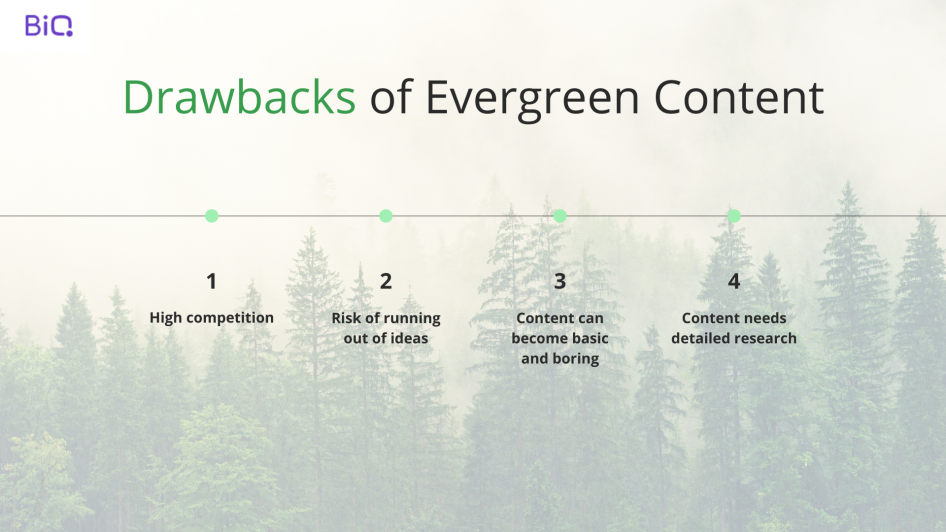
1. High competition
The competition to get a higher ranking on Google SERPS is very high as almost everyone uses evergreen content for their websites. You will be covering almost the same topics as your competitors, so the pressure to do it differently from your competitors in order to be relevant is very high.
2. Risk of running out of ideas
With time, you are likely to run out of new topics you can cover. If approached without caution, you could end up with content that lacks originality and scare away your audience. Evergreen content needs a lot of creativity to stay relevant.
3. Content can become basic and boring
Over time, evergreen content may become obvious and boring to the audience. For example, how-to-guides may be the same across a number of sites. Since evergreen content is mostly long-form, your audience could lose interest midway if the post is not engaging enough.
4. Content needs detailed research
While seasonal content needs you to only keep up with the trending topics, evergreen content requires you to do detailed research so that you can come up with informative and engaging content. The focus is on quality and not quantity.
Seasonal Content Pros:
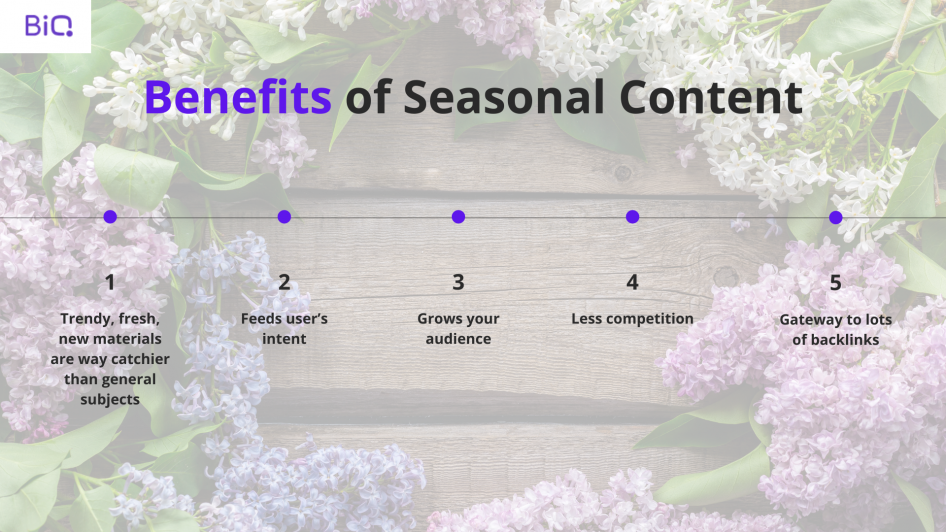
1. Trendy, fresh, new materials are way catchier than general subjects
Seasonal articles generally trigger more interest compared to those they’ve seen countless times. It also shows that you care about up-to-date news. As long as you’re in the right season or time frame, your work stands to attract much more attention than an evergreen counterpart would.
2. Feeds user’s intent
Seasonal articles are good for selling as it provides instant gratification. The article that you craft will help your audience make better decisions from a marketing and purchasing point of view during that specific period.
3. Grows your audience
Seasonal content is great for instant success, word-of-mouth, and virality. It is a contributing factor to your brand’s recognition and reputation. When interesting subjects are discussed, they might be more likely to get shared on social media.
4. Less competition
Apart from a few industries such as fashion and tech, few brands use seasonal content. As long as you can consistently create content that is relevant to the trending topics and tap into people’s fear of missing out (FOMO), you will be able to attract audiences to your site.
5. Gateway to lots of backlinks
When done and timed right, seasonal content can get you a lot of backlinks. When the brand establishes itself as an authority within the industry, other websites will link back to it. This allows the brand to also boost other posts on the website that have much traffic by using an internal linking strategy.
Seasonal Content Cons:
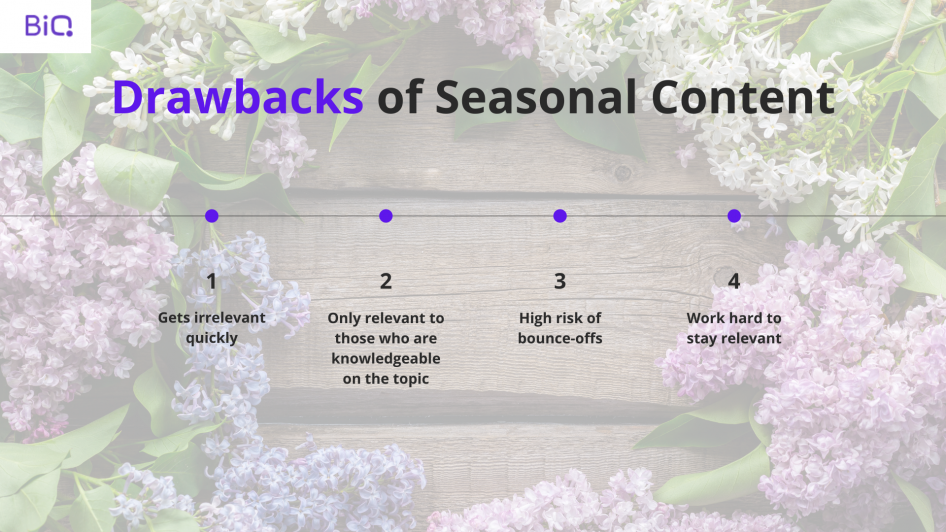
1. Gets irrelevant quickly
As time goes by, seasonal content becomes stale and irrelevant. Though it comes with high traffic, the traffic only lasts as long as the trend. It is a short-term engagement strategy with a limited lifespan.
2. Only relevant to those who are knowledgeable on the topic
Seasonal content only generates hype among audiences who are well-versed on the topic. This means that the rest of your audience will find the information irrelevant and of no use to them. New audiences might feel left out if they have no idea of what is being talked about.
3. High risk of bounce-offs
Seasonal content is only relevant to people who have an interest in particular topics. People who have no interest may click on a link just because of curiosity then leave the site soon thereafter. Know that high rates of bounce-offs could jeopardize your SEO ranking.
4. Work hard to stay relevant
Because of its quick turnover time, seasonal content forces you to work hard to stay updated and relevant on the latest trending topics. You have to have your ears out on a daily or you risk missing out on topics that could be important to the brand.
Key Evaluation Factors
This last point hints at a bigger picture issue. It’s a mistake to look at content publishing simply as a matter of Search Engine Optimization (SEO).
Yes, SEO is absolutely critical. You won’t get clicks if you don’t get ranked in search results. However, it’s imperative to think through what happens once the site visitor clicks on your content link:
- What impressions will he or she form about your business, based on the content?
- Does the content have a strong Call to Action (CTA) that prompts a purchase or meaningful engagement?
- Does the content start (or reinforce) a lasting customer relationship?
- Is it credible with reputable sources and statistics to back up your claims?
- Are you providing original, unique and relevant data?
Factor in these questions before you start writing and decide which type of content suits you better.
Who Is Going To Read It?

Whoever they are, you should know best.
Most people will search for the answer to the question “How do I find my audience?” But little do they know that that isn’t the right question to ask. Instead, the question that will make your content successful, “Who am I talking to?” Always identify who you’re talking to first, then focus on finding them online.
When creating content, it’s a good practice to assess the audience carefully (age, gender, occupation, etc) and write accordingly. Most people these days don’t even stop to think about who is going to be reading their content and why they’re going to read it — they just proceed with writing it.
It’s easy to fall into the habit of writing to impress your peers or editor. That might make for good writing but it won’t necessarily attract readers. Style, tone, and subject matter are taken into account here. Hence it is wise to create your reader personas.
These reader personas seek to document the real motivations and curiosities that empower your readers. By identifying them, you’ll be able to find your target audience better when the time comes.
For example, if your audience is men, aged 30-60 who enjoy the outdoors, then writing in a hip, Generation Z style is probably going to fail in achieving engagement. If people who land on your site are not your targeted audience, then they won’t finish reading your articles.
After all, the whole point of creating content is to attract prospective customers and then communicating with them to gain their interest.
On a higher level, think about the people who are going to read the material. One mistake in SEO content writing is to assume that only a machine (Google) is ever going to read the piece.
This may be true, partly. However, it’s a really good idea to make the content appealing to a human reader. If it looks like a template stuffed with key phrases, that’s a turnoff.
Don’t forget: You have to answer real people. That’s what makes content successful. It’s important to make a distinction before writing your content, otherwise, you’re just wasting your time.
Seasonal vs Evergreen: The Value of a Hybrid Approach

Sometimes, sticking to one type of content could be restricting for the brand and it may fail to reach its full potential. Remember that relevance is key no matter which strategy you choose to go with. Always do market research to understand which topics are relevant to your audience.
The best approach is to do both by balancing how you plan to publish both types of content. This style is called the hybrid model – where you balance between the two types of content.
The essence is to take advantage of both for a mutually beneficial goal. How? You can dedicate 80% to your evergreen content and dedicate 20% to seasonal promotional content strategy. By using this approach, you can reach audiences with permanent and seasonal needs.
To ensure your hybrid model remains relevant, measure the previous performance of both content types, and create an actionable editorial calendar that incorporates both kinds of content for an optimal content strategy that promises to earn you traffic and boost your brand marketing and sales.
As for me, I personally tend to publish more on evergreen content with some seasonal content in between when situations need me to be. So yes, my focus is placed mainly on evergreen content. I would also say that all of your work should strive to have long-lasting value for your audience.
With that, I hope you’ve had an enjoyable read thus far. Would you want to share your take on this? Are you currently an advocate for seasonal content or evergreen content? If you’ve just started out, which approach appeals to you better? Let me know your thoughts in the comment section below!




